I am looking for a reliable electronic burner regulator that I can use to hook up tp my burner that uses a Ranco temperature contoller. I want to control the temp on my HLT and use a HERMS system in it. Does anyone have any suggestions or ideas on how to get my hands on such a regulator?
You are using an out of date browser. It may not display this or other websites correctly.
You should upgrade or use an alternative browser.
You should upgrade or use an alternative browser.
Automated Burner Regulator
- Thread starter thach1aj
- Start date

Help Support Homebrew Talk - Beer, Wine, Mead, & Cider Brewing Discussion Forum:
This site may earn a commission from merchant affiliate
links, including eBay, Amazon, and others.
BetterSense
Well-Known Member
If you implement this, you need to have a pilot light, and that means you have to have a proper gas valve with a thermocouple to prevent explosions in case the pilot light blows out. And the cheap gas valves used for residential gas stuff will not work with propane burners because the pressure is different. At least that's what I found out when I was looking into it; if someone else has a way I would like to know.
Ryan_PA
Well-Known Member
This is the diagram for the Auber PID, but your Ranco would function very similarly:
https://www.homebrewtalk.com/f51/one-stop-shop-tutorial-automated-propane-209780/#post2453714
https://www.homebrewtalk.com/f51/one-stop-shop-tutorial-automated-propane-209780/#post2453714
OneHoppyGuy
Well-Known Member
This parts list is what we use.
It's expensive but extremely reliable and very safe.
Gas is no joke, play it safe!
http://www.pexsupply.com/Honeywell-Y8610U4001-Intermittent-Pilot-Control-Conversion-Kit
http://www.pexsupply.com/Honeywell-Q314A4586-Honeywell-Q314A4586-Pilot-Burner-4113000-p
http://www.pexsupply.com/Honeywell-...el-Mounted-120-Vac-Transformer-40VA-4559000-p
http://www.pexsupply.com/Robertshaw-11-293-1-4-x-5-Pilot-Burner-Tubing-w-Fittings
It's expensive but extremely reliable and very safe.
Gas is no joke, play it safe!
http://www.pexsupply.com/Honeywell-Y8610U4001-Intermittent-Pilot-Control-Conversion-Kit
http://www.pexsupply.com/Honeywell-Q314A4586-Honeywell-Q314A4586-Pilot-Burner-4113000-p
http://www.pexsupply.com/Honeywell-...el-Mounted-120-Vac-Transformer-40VA-4559000-p
http://www.pexsupply.com/Robertshaw-11-293-1-4-x-5-Pilot-Burner-Tubing-w-Fittings
OneHoppyGuy
Well-Known Member
No. The solenoid mimics the gas valve to a degree.
Use the parts listed.
A furnace gas valve is a 2 stage solenoid. First stage opens the pilot valve and the igniter begins pulsing arcs at the pilot orifice. When the thermocouple (located near the pilot) is at temperature from the pilot flame, the main valve opens. Whenever the thermocouple drops below required temperature (flame out), the main valve closes and the igniter and pilot restarts the cycle.
The igniter will attempt for x number of seconds, If flame does not occur, the igniter will stop for a few minutes and then repeat the cycle.
This design prevents gas flow if the flame goes out.
Standing pilots can blow out.
The big boy on the brew sculpture block uses a standing pilot... booo
Use the parts listed.
A furnace gas valve is a 2 stage solenoid. First stage opens the pilot valve and the igniter begins pulsing arcs at the pilot orifice. When the thermocouple (located near the pilot) is at temperature from the pilot flame, the main valve opens. Whenever the thermocouple drops below required temperature (flame out), the main valve closes and the igniter and pilot restarts the cycle.
The igniter will attempt for x number of seconds, If flame does not occur, the igniter will stop for a few minutes and then repeat the cycle.
This design prevents gas flow if the flame goes out.
Standing pilots can blow out.
The big boy on the brew sculpture block uses a standing pilot... booo
bumstigedy
Member
I might have to try this.
mikelikesit2000
Well-Known Member
Question: Are three of the honeywell pilot control kits required? One for each burner?
OneHoppyGuy
Well-Known Member
That is correct - 3 totaling $750...
Like I said, it's expensive but so are limbs, eye site and life.
Like I said, it's expensive but so are limbs, eye site and life.
Here is a comparison for automatic gas burner control:
Spark Ignition
Valve - http://www.pexsupply.com/Honeywell-VR8204A2076-Standard-Dual-Intermittent-Pilot-Gas-Valve-13663000-p
Ignition - http://www.pexsupply.com/Honeywell-S8610U3009-Intermittent-Pilot-Control-4584000-p
Pilot burner - http://www.pexsupply.com/Honeywell-Q345A1305-Pilot-Burner-For-Natural-Gas-14525000-p
Tubing - 1/4" soft copper from HD or Lowes
Transformer - 1 Valve http://www.pexsupply.com/Honeywell-AT140A1000-Foot-Mounted-Plate-Mounted-Clamp-mounted-or-Panel-Mounted-120-Vac-Transformer-40VA-4559000-p
Transformer for 2 valves - http://www.pexsupply.com/Honeywell-AT175F1023-Plate-or-planel-mounted-120-208-240-Vac-Transformer-with-9-in-lead-wires-and-metal-end-bells
For standing pilot control:
Valve - http://www.pexsupply.com/Honeywell-VR8200A2132-1-2-24-Vac-Standing-Pilot-Gas-Valve-11588000-p
Pilot burner - http://www.pexsupply.com/Honeywell-Q314A6094-Honeywell-Q314A6094-Pilot-Burner
Thermocouple - http://www.pexsupply.com/Honeywell-Q390A1046-24-Thermocouple-1721000-p
Tubing - 1/4" soft copper from HD or Lowes
Transformers are the same as above.
The standing pilot approach is cheaper but you need to light up the pilots each time you get ready to start brewing. The electric ignition is just throw the switch and it takes care of lighting the pilot, which senses flame on the ignition rod and allows the main gas valve to open.
Spark Ignition
Valve - http://www.pexsupply.com/Honeywell-VR8204A2076-Standard-Dual-Intermittent-Pilot-Gas-Valve-13663000-p
Ignition - http://www.pexsupply.com/Honeywell-S8610U3009-Intermittent-Pilot-Control-4584000-p
Pilot burner - http://www.pexsupply.com/Honeywell-Q345A1305-Pilot-Burner-For-Natural-Gas-14525000-p
Tubing - 1/4" soft copper from HD or Lowes
Transformer - 1 Valve http://www.pexsupply.com/Honeywell-AT140A1000-Foot-Mounted-Plate-Mounted-Clamp-mounted-or-Panel-Mounted-120-Vac-Transformer-40VA-4559000-p
Transformer for 2 valves - http://www.pexsupply.com/Honeywell-AT175F1023-Plate-or-planel-mounted-120-208-240-Vac-Transformer-with-9-in-lead-wires-and-metal-end-bells
For standing pilot control:
Valve - http://www.pexsupply.com/Honeywell-VR8200A2132-1-2-24-Vac-Standing-Pilot-Gas-Valve-11588000-p
Pilot burner - http://www.pexsupply.com/Honeywell-Q314A6094-Honeywell-Q314A6094-Pilot-Burner
Thermocouple - http://www.pexsupply.com/Honeywell-Q390A1046-24-Thermocouple-1721000-p
Tubing - 1/4" soft copper from HD or Lowes
Transformers are the same as above.
The standing pilot approach is cheaper but you need to light up the pilots each time you get ready to start brewing. The electric ignition is just throw the switch and it takes care of lighting the pilot, which senses flame on the ignition rod and allows the main gas valve to open.
JuanMoore
Getting the banned back together
That is correct - 3 totaling $750...
Like I said, it's expensive but so are limbs, eye site and life.
The same safety features can be had much cheaper with a standing pilot if you don't mind manually lighting the pilot at the start of each brew day. I absolutely agree that a dual stage valve with a thermocouple is the way to go for automated burners, for the same limbs/eyesight/life reasons you mentioned. Here's what you'd need:
Edit: I got distracted and kladue beat me to posting the parts list, and he even provided nice links.
Question: Are three of the honeywell pilot control kits required? One for each burner?
You don't really need one for the boil kettle. After all, you'd normally just light the burner once at the start of the boil, and then shut it off when the boil is complete, so automation doesn't really help any. I suppose there is the safety feature that it will shut off the gas if the flame goes out, but that's much less likely if the burner isn't being turned on and off, and I don't leave it unattended during the boil anyway. For my HERMS I only automated the HLT burner. There is no MLT burner, and I don't mind lighting the BK burner by hand.
OneHoppyGuy
Well-Known Member
kladue... I check out the parts you listed... (putting them in the shopping cart) The setup I listed was aprox. $206 with shipping.. I win... 
Ditto on what Juan says about the boil kettle. You have to babysit it, which is the most difficult part of the brewing day: You've already had a few beers and now you have to pay attention...
Something I am going to start using is the electronic igniters used on barbecues these days. Better than a piezio igniter IMO.. And the link I sent says they have them at WallyWorld

Ditto on what Juan says about the boil kettle. You have to babysit it, which is the most difficult part of the brewing day: You've already had a few beers and now you have to pay attention...
Something I am going to start using is the electronic igniters used on barbecues these days. Better than a piezio igniter IMO.. And the link I sent says they have them at WallyWorld
OneHoppyGuy
Well-Known Member
Ranco will work fine
OneHoppyGuy
Well-Known Member
You are most welcome!
bumstigedy
Member
Is there a step by step guide on how to hook all this stuff up somewhere?
mikelikesit2000
Well-Known Member
The same safety features can be had much cheaper with a standing pilot if you don't mind manually lighting the pilot at the start of each brew day. I absolutely agree that a dual stage valve with a thermocouple is the way to go for automated burners, for the same limbs/eyesight/life reasons you mentioned. Here's what you'd need:
Edit: I got distracted and kladue beat me to posting the parts list, and he even provided nice links.
You don't really need one for the boil kettle. After all, you'd normally just light the burner once at the start of the boil, and then shut it off when the boil is complete, so automation doesn't really help any. I suppose there is the safety feature that it will shut off the gas if the flame goes out, but that's much less likely if the burner isn't being turned on and off, and I don't leave it unattended during the boil anyway. For my HERMS I only automated the HLT burner. There is no MLT burner, and I don't mind lighting the BK burner by hand.
I have already set aside three asco valves for this project. I was going to use them for the supply to the burners, but now I am thinking that its not the best way. I would have to use standing pilots in order to use the asco valves, right? i also bought three (Chinese)120v digital temp controllers to control the asco valves which are also 120v. Do you think I could use a single pilot valve to control three pilot lights?
OneHoppyGuy
Well-Known Member
Is there a step by step guide on how to hook all this stuff up somewhere?
Guess it's time for me to do one...
OneHoppyGuy
Well-Known Member
Mount gas valve to gas supply line manifold. This typically should have a regulator mounted just before this Gas Valve
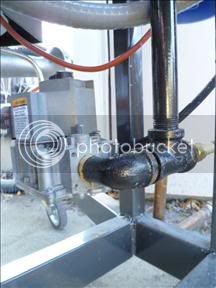
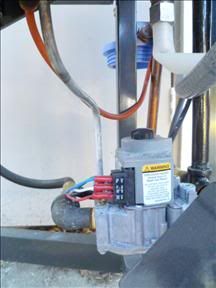
Pilot and igniter mount
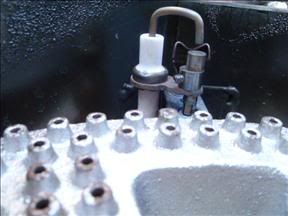
Transformer and control module. Signal from temperature controller is wired to the 24VAC+ terminal on the control module. (This tells the module to light)
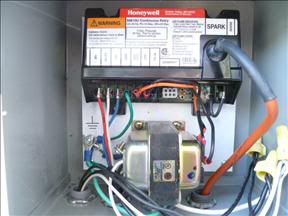
Gas Valve to Burner connection
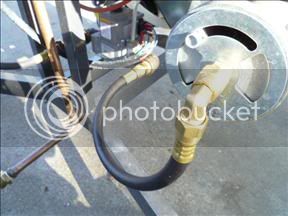
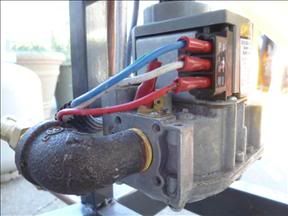
How many stand building companies do you know that would show you how to do on your own what they charge others to do? :fro:


Pilot and igniter mount

Transformer and control module. Signal from temperature controller is wired to the 24VAC+ terminal on the control module. (This tells the module to light)

Gas Valve to Burner connection


How many stand building companies do you know that would show you how to do on your own what they charge others to do? :fro:
bumstigedy
Member
Thanks! This is great information.
For those folks that want electric ignition with flame safety and high pressure operation you can use 2 - 24VAC solenoid valves per burner. First solenoid is to fire a Q345 pilot burner with flame sense, and second is for burner fuel flow but both need to have 24 VAC coils. Since the propane pressure is around the 10 PSI range you can get good performance with a 1/4" valve because the gas density is so high. For the pilot side a needle valve is needed, and a low pressure regulator makes steady flame size easier if you adjust high pressure regulator up and down. For burner plumbing you can go as small as 1/4" OD but most folks use 3/8" copper and flare fittings.
STC 2W025 - 1/4" 24 VAC Solenoid valves can be sourced from here http://www.allair.com/svalve/Process%20Valve.htm, or Fremont industrial supply, when ordering seals need to be "Viton", coil voltage needs to be "24 VAC" not "24 VDC".
I and a few others have high pressure propane systems with electric ignition system controllers, but it is way cheaper to go with low pressure standing pilot systems, ~ $80 a burner.
STC 2W025 - 1/4" 24 VAC Solenoid valves can be sourced from here http://www.allair.com/svalve/Process%20Valve.htm, or Fremont industrial supply, when ordering seals need to be "Viton", coil voltage needs to be "24 VAC" not "24 VDC".
I and a few others have high pressure propane systems with electric ignition system controllers, but it is way cheaper to go with low pressure standing pilot systems, ~ $80 a burner.
OneHoppyGuy
Well-Known Member
What would be a good choice for a low pressure burner?
as in? which burner are you referring to?
This is the most popular choice for HLT and Boil Kettle burners is the 10" BG-14 http://www.agrisupply.com/bg-high-pressure-cast-iron-burner-/p/64494/cn/6000138/
And the 6" BG-12 for the Mash tun burner for direct fired RIMS http://www.agrisupply.com/burner-cast-low-presure-multi-hole-/p/40282/cn/6000138/.
Avoid the multi Jet burners because they are too much fire for most systems and when the fire is turned down they will not burn clean.
And the 6" BG-12 for the Mash tun burner for direct fired RIMS http://www.agrisupply.com/burner-cast-low-presure-multi-hole-/p/40282/cn/6000138/.
Avoid the multi Jet burners because they are too much fire for most systems and when the fire is turned down they will not burn clean.
The burners presented are more than large enough, more than 80K btu's under a 16" pot or keggle just goes up the sides. Mega btu burners will burn all the external bits off the pot for you and produce impressive flames, but will still heat the water inside as fast as a 10" burner will. The idea is to have the flame stay under the pot as long as possible doing something instead of going up the sides. When operated on low pressure propane or NG the BG-14 will produce roughly 80K btu's which is just right.
Ryan_PA
Well-Known Member
I brought 40 gallons, inside a 55 gallon drum, to a boilover with the above linked 6 inch burner. You will never need anything larger. However, I also have the 10 inch since it just looks so impressive. (I also can make an argument for more even heating due to burner surface area, but it is at best, a nominal effect)
Kind of a dead thread but what the hell I'll post. I've been looking to switch from a herms coil setup to a direct fire rims. If you use just the solenoid valve, how does the thermocoupler turn off gas to the pilot? Will it connect to the solenoid leads? And isn't there a 120 volt solenoid for the main gas to burner shutoff, so you could avoid using two transformers? I'm assuming the scenario kladue described with two solenoids
Hello!
I had an idea for a cheap electric gas power regulation.
https://docs.google.com/file/d/0B-M0tOtiFDzsRHlYLWM0Z2dSMjg/edit
S1 - Electric gas solenoid
V1 - High flame regulation
V2 - Minimum flame regulation
I had an idea for a cheap electric gas power regulation.
https://docs.google.com/file/d/0B-M0tOtiFDzsRHlYLWM0Z2dSMjg/edit
S1 - Electric gas solenoid
V1 - High flame regulation
V2 - Minimum flame regulation
Hello!
I had an idea for a cheap electric gas power regulation.
https://docs.google.com/file/d/0B-M0tOtiFDzsRHlYLWM0Z2dSMjg/edit
S1 - Electric gas solenoid
V1 - High flame regulation
V2 - Minimum flame regulation
not to bad of an idea but I can say that even with my pilot light on, if adjusted to high and the liquid level starts getting low it will scortch the bottom. I don't think you could regulate the burner low enough to maintain control of the heat, meaning I think you would be adding to much heat when on the "low" burner setting you refer to.
give it a shot and let us know how it works.
Similar threads
- Replies
- 0
- Views
- 215
- Replies
- 1
- Views
- 426
- Replies
- 13
- Views
- 1K

